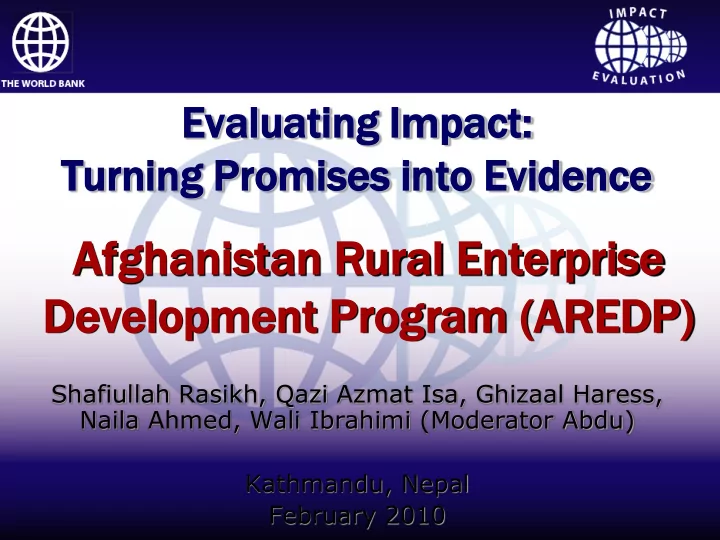

Ev Evaluating aluating Im Impact: act: Tu Turning ning Promises omises in into to Ev Evid idence ence Af Afgh ghanis anistan tan Rur ural al Enterpris prise e Developmen lopment t Prog rogram ram (A (ARE REDP) P) Shafiullah Rasikh, Qazi Azmat Isa, Ghizaal Haress, Naila Ahmed, Wali Ibrahimi (Moderator Abdu) Kathmandu, Nepal February 2010
KEY ISSUES: 75% of population live in rural areas where agriculture is the primary activity; High unemployment rates and unskilled labor force; Shortage of business planning, management, and marketing know-how; and access to formal credit 2
PROJECT DESCRIPTION PDO: To improve employment opportunities and income of rural men and women; and sustainability of targeted local enterprises Program Components: (a) Community-led Enterprise Development; (b) Small and Medium Enterprise Development; 3
Initiate savings Form and register groups and monitor Village Savings and internal lending Loan Associations Seed grant to mature VSLAs Initiate enterprise BDS delivery and groups and develop VSLA lending to enterprise plans enterprise groups Situation analysis and value chain assessment Identify SMEs and Inventory and Initiate financial contract of BDS literacy with SMEs providers Innovation awards Identify Partial Commercial bank Guarantee lending and BDS Administrator delivery to SMEs Discussion with banks to identify support need 4
2. Results Chain Long-term Inputs Outputs Outcomes Activities Outcomes Human Unemployment Community 30% of CDCs in a Well-governed Resources; mobilization province organized community groups; decreased into groups (35 % Financial Net revenues female) Resources increased for SMEs 70% of groups Delivery of technical Improved savings & Incomes -Livelihood support and federate to VSLAs, inter-loaning and grants to the increased for the facilitation access to formal credit 80% of VSLAs comm unities households by community groups receive grants and Women - Partial linked to MFIs; Guarantee Empowered Employment Business Development 750 SMEs Funds for Increased private Services to SMEs supported by the increased through SMEs sector investment; project; SMEs Improved SMEs accessing productivity and more financial economic stability; resources High net revenues to SMEs 5
3. Primary Research Questions Q1: Did AREDP have an impact on increasing incomes of participating households? Q2: Did AREDP increase women participation in enterprise activities? Q3: Did the Business Development Services under AREDP have an impact on increasing net revenues of local enterprises? 6
4. Outcome Indicators Number of Well-governed community groups Percentage of groups demonstrating improved savings & access to formal credit; At least 30% increase in employment through SMEs SMEs accessing loans from financial institutions and have at least 50% higher net revenues 7
5. Identification Strategy/Method Selection of Communities: STAGE 1: NSP covers 75% of Afghanistan with est. 22,000 CDCs; STAGE 2: Roll-out: YR1 7 Provinces; YR2 Contingent on funding and performance to roll-out to all 34 Provinces; Selection criteria: security, better entrepreneurial opportunities; STAGE 3: Districts and villages will be selected. Selection criteria: accessibility, better performing CDCs, and demand for project; STAGE 4: Households self select into Program: Selection criteria: Interest to participate, ability to save. STAGE 5: AREDP community groups form as savings or enterprise groups. Selection of SME’s: Baseline survey of 1708 SMEs in 33 Provinces (2008); 8
Identification Strategy/Method Criteria Potential FUNDING 7 selected 27 counterfactual: provinces remaining provinces At each stage, there are potential e.g. Accessibility members of Selected Remainin communities who Districts g Districts would have been benefited from the Program but have been left e.g. CDC out due to performance Remaining Selected several reasons. Villages Villages Potential Control Groups Treatment 9
5. Identification Strategy/Method Random Sample of non-participants will be drawn from potential control groups; Impact Evaluation Method With respect to the Community groups: Q1 and Q2: Matching With respect to the SMEs: Q3: Difference in difference 10
6. Sample and data Sample selection and Size Universe: Avg. 1000 CDCs per Province under NSP; 7000 CDCs are our universe from which AREDP will select 30% (2000 CDCs); Size: Consultation with the Central Statistics Office to determine a nationally representative sample size; Data Collection Method Quantitative methods: Design questionnaires to capture Household, Community and SME data; Qualitative methods: To capture process related information: stakeholders include elected reps. Focus group discussions, 11
7. Time Frame/Work Plan Timeframe: Baseline: 2010 Mid-term review: 2012 Final survey: 2015 Process monitoring (throughout) Work plan (e.g. activity: survey implementation and data analysis) Consultative process to include variety of stakeholders; Design of survey instruments Pre-testing survey instruments Contracting of survey firm Survey equipment, tools Full survey implementation Post survey (data cleaning, verification) Analysis to answer Q1, Q2 and Q3 Report writing 12 Dissemination
8. Sources of Financing Approx. 2% of project cost which is in the project budget. Approx. $1.5 million Other possible funding. 13
Recommend
More recommend